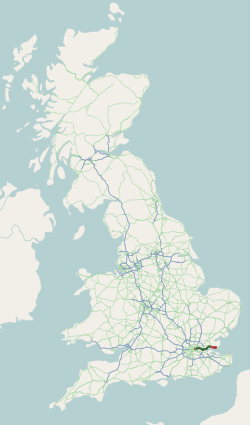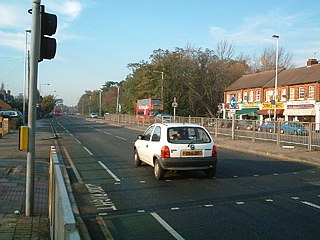Related Research Articles

The Docklands Light Railway (DLR) is an automated light metro system primarily serving the redeveloped Docklands area of London and providing a direct connection between London's two major financial districts, Canary Wharf and the City of London. First opened on 31 August 1987, the DLR has been extended multiple times, giving a total route length of 38 km. Lines now reach north to Stratford, south to Lewisham, west to Tower Gateway and Bank in the City of London financial district, and east to Beckton, London City Airport and Woolwich Arsenal. An extension to Thamesmead is currently being proposed.

The Blackwall Tunnel is a pair of road tunnels underneath the River Thames in east London, England, linking the London Borough of Tower Hamlets with the Royal Borough of Greenwich, and part of the A102 road. The northern portal lies just south of the East India Dock Road (A13) in Blackwall; the southern entrances are just south of The O2 on the Greenwich Peninsula. The road is managed by Transport for London (TfL).

The Woolwich Ferry is a free vehicle and pedestrian ferry across the River Thames in East London, connecting Woolwich on the south bank with North Woolwich on the north. It is licensed and financed by London River Services, the maritime arm of Transport for London (TfL). Around two million passengers use the ferry each year.

London River Services Limited is a division of Transport for London (TfL), which manages passenger transport—leisure-oriented tourist services and commuter services—on the River Thames in London. It does not own or operate any boats itself, except those of the Woolwich Ferry, but licenses the services of operators.

The A13 is a major road in England linking Central London with east London and south Essex. Its route is similar to that of the London, Tilbury and Southend line via Rainham, Grays, Tilbury, Stanford-Le-Hope & Pitsea, and runs the entire length of the northern Thames Gateway area, terminating on the Thames Estuary at Shoeburyness. It is a trunk road between London and the Tilbury junction, a primary route between there and Sadlers Hall Farm near South Benfleet, and a non-primary route between there and Shoeburyness.

The Thames Gateway Bridge was a proposed crossing over the River Thames in east London, England. It was first mooted in the 1970s but never came to fruition. The concept was re-proposed in 2004, with preliminary planning proceeding until November 2008, when Boris Johnson, the Mayor of London, cancelled the entire £500 million scheme.

Abbey Wood is a National Rail station in Abbey Wood in southeast London, England. It is between Plumstead and Belvedere stations on the North Kent Line. It is 11 miles 43 chains (18.6 km) measured from London Charing Cross, with services to central London routed via Greenwich or Lewisham, and Elizabeth line services to Paddington and Reading via Canary Wharf and Liverpool Street. The station is managed by Transport for London with passenger services provided by Southeastern, Thameslink and the Elizabeth line. It is the closest railway station to the suburb of Thamesmead, which is connected to the station by local buses. The station platforms are located in the Royal Borough of Greenwich with the station entrance in the London Borough of Bexley.

East London Transit (ELT) is a part-segregated bus rapid transit, operated as part of the London Buses network. The East London Transit opened in phases between 2010 and 2013. The scheme for this system was developed by Transport for London to meet the existing and anticipated demand for public transport in East London caused by the Thames Gateway redevelopment, and has been planned to allow for a possible future upgrade to tram operation.

The Silvertown Tunnel is a road tunnel under construction beneath the River Thames in London, England. It will be built from west Silvertown on the north bank to the Greenwich Peninsula on the south bank. On the southern end it will begin at the same location as the existing Blackwall Tunnel but ends up a mile east of it on the northern side, to the east of the River Lea estuary.

London has an extensive and developed transport network which includes both public and private services. Journeys made on its integrated transport network account for 37% of London's journeys while private services accounted for 36% of journeys, walking 24% and cycling 2%, according to numbers from 2017. London's public transport network serves as the central hub for the United Kingdom in rail, air and road transport.

Cross River Tram was a Transport for London (TfL) proposal for a 10-mile (16 km) tram system in London. It was planned to run on a north–south route from Camden Town in the north, via King's Cross, to Peckham and Brixton in the south.

The West London Tram was a proposed on-street light rail line that was to run along the Uxbridge Road (A4020) corridor in West London, England. The scheme was promoted by Transport for London (TfL). It was postponed indefinitely on 2 August 2007, as it was opposed by the councils of all three bisected London Boroughs.

The Bakerloo line extension is a proposed extension of the London Underground Bakerloo line in South London from its current terminus at Elephant & Castle to Lewisham station.

The London cable car, also known as the Dangleway and officially as the IFS Cloud Cable Car for sponsorship reasons, is a cable car link across the River Thames in London, England. The line was built by Doppelmayr and the total cost was around £60 million. The service opened on 28 June 2012 and is operated by Transport for London (TfL). Since 20 October 2022, it has been sponsored by the technology firm IFS; prior to this, from its opening the line was sponsored by the airline Emirates, and known as the Emirates Air Line until 28 June 2022.

The Gallions Reach Crossing was a proposed River Thames crossing close to Gallions Reach in East London, running between Beckton in the London Borough of Newham and Thamesmead in the Royal Borough of Greenwich. Originally a proposed ferry crossing replacing the Woolwich Ferry, later plans suggested either a bridge or a tunnel.

Barking Riverside is a railway station in the London Borough of Barking and Dagenham, East London. The eastern terminus of the Suffragette line of the London Overground, the station serves the Barking Riverside regeneration area and was built as part of a £327m extension of the Gospel Oak to Barking line. It opened on 18 July 2022 and provides interchange with the Uber Boat by Thames Clippers boat service from Barking Riverside Pier.
The Docklands Light Railway extension to Thamesmead is a proposed Docklands Light Railway (DLR) extension to serve the Beckton Riverside and Thamesmead redevelopment areas of East London.
Cycleway 4 is a fully segregated cycle path in London originally planned to run from Tower Bridge to Woolwich and coordinated by Transport for London. First proposed in 2008 but first consulted on as Cycle Superhighway 4 between Tower Bridge and Greenwich in 2017, the cycle lane has been in lengthy development. The section from Tower Bridge to Rotherhithe Roundabout, and the section on Evelyn Street and Creek Road, has been built as a permanent scheme.
References
- 1 2 Fisk, Robert (6 November 2008). "Greenwich shocked at Thames Gateway decision". News Shopper. Retrieved 28 December 2020.
- ↑ "Barking Riverside Extension Transport options summary report". Transport for London. Archived from the original on 5 April 2016. Retrieved 22 June 2017.
- ↑ "Mapping The Changes" (PDF). The Londoner. March 2006. Archived from the original (PDF) on 13 July 2009. Retrieved 4 February 2010.
- ↑ "alwaystouchout.com – East London Transit". www.alwaystouchout.com. Retrieved 28 December 2020.
- ↑ "East London Transit | Transport for London". Transport for London . 12 January 2008. Archived from the original on 12 January 2008. Retrieved 28 December 2020.
- ↑ "Trolleycoaches for London". www.tbus.org.uk. Retrieved 28 December 2020.
- ↑ "Greenwich Waterfront Transit: the history, cancellation and rebirth | Murky Depths". From the Murky Depths. 26 February 2019. Retrieved 28 December 2020.
- ↑ "alwaystouchout.com – Greenwich Waterfront Transit". www.alwaystouchout.com. Retrieved 28 December 2020.
- ↑ "Greenwich Waterfront Transit | Transport for London". Transport for London . 7 February 2008. Archived from the original on 7 February 2008. Retrieved 28 December 2020.
- ↑ "Greenwich Waterfront Transit scrapped". www.transportxtra.com. 3 April 2009. Retrieved 28 December 2020.
- ↑ "alwaystouchout.com – Thames Gateway Bridge". www.alwaystouchout.com. Retrieved 28 December 2020.
- ↑ "Thames Gateway Transit | Transport for London". Transport for London . 14 February 2008. Archived from the original on 14 February 2008. Retrieved 28 December 2020.